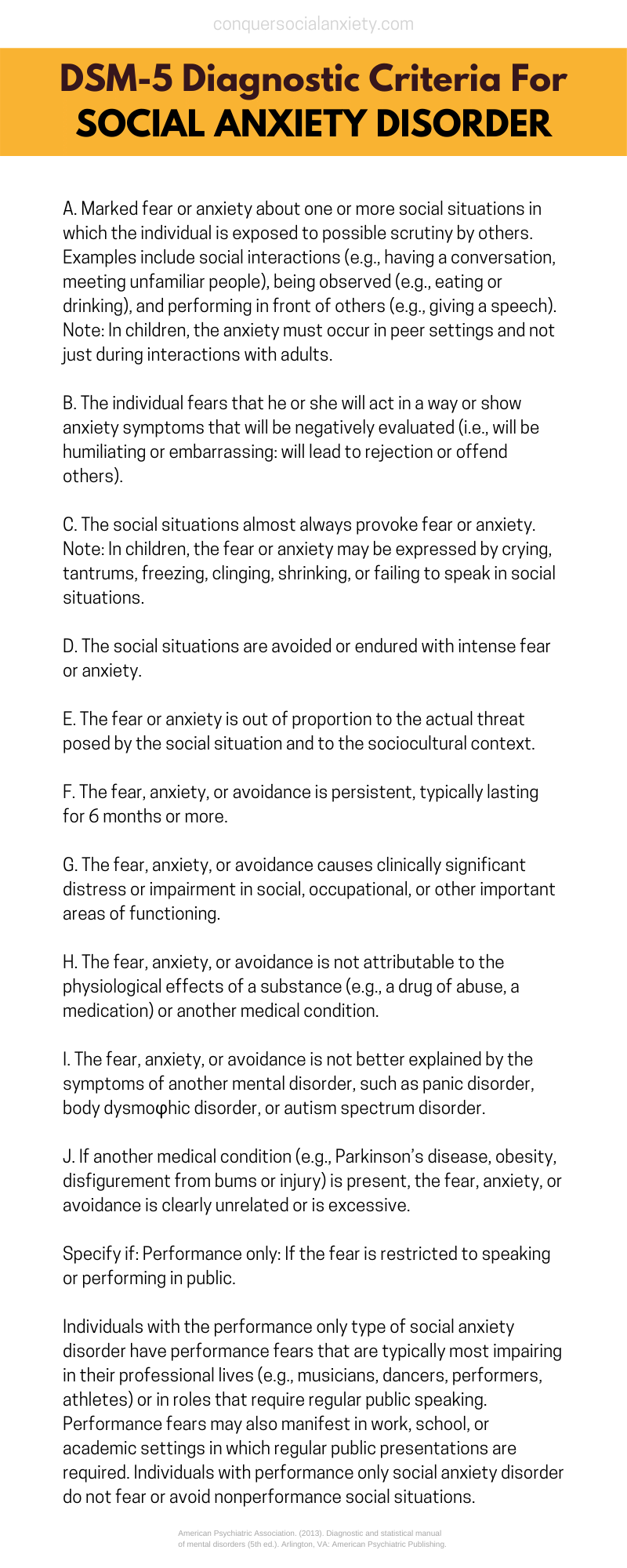
It is possible for people to have "clinical cases" of both panic disorder and social anxiety disorder, as defined by the DSM-5. Great confusion exists in the psychiatric/psychological community about this.ĥ. That is, people can exhibit symptoms of a disorder, but not experience the number of symptoms necessary to be clinically diagnosed with the disorder.

However, these associations do NOT usually rise to the level of diagnostic "labeling". Demographic and epidemiological studies show correlations between many mental health care disorders. There needs to be a clear distinction between these terms, as many people are misdiagnosed as a result of the current language in the DSM-5.Ĥ. People with social anxiety disorder may experience "anxiety" attacks that are situationally bound, but they do not experience "panic" attacks, which, by definition, initially precipitate feelings of a medical emergency (i.e., fear of losing control, heart attack, and dying, to name a few). See our article on the differences between Panic Disorder (with and without agoraphobia) and Social Anxiety Disorder for further details.ģ. The use of the term "Panic Attack", which is the name of a separate anxiety disorder, is confusing and can prevent a proper diagnosis from being made. The reference in "B" to a situationally bound or situationally pre-disposed Panic Attack is not clearly defined. The descriptive language is generally good, but could be more direct and precise.Ģ. Here is where the current DSM needs to be revised:ġ. Thus, the definition of social anxiety disorder is becoming clearer and more precise with each edition. While this definition is clearly the most definitive and precise official definition produced so far, "social anxiety disorder" has only been officially recognized since 1980, and the problem did not become adequately explained until the 1987 version of the DSM. Please note that while this definition of social anxiety is the most definitive and clearest explanation to date, there are several potential problems with this definition that will hopefully be addressed in future editions. The fear or avoidance is not due to direct physiological effects of a substance (e.g., drugs, medications) or a general medical condition not better accounted for by another mental disorder.Ĭopyright 2013, The American Psychiatric Association Problems with the DSM Definition of Social Anxiety The fear, anxiety, or avoidance is persistent, typically lasting 6 or more months. The avoidance, anxious anticipation, or distress in the feared social or performance situation(s) interferes significantly with the person's normal routine, occupational (academic) functioning, or social activities or relationships, or there is marked distress about having the phobia.į. The feared situations are avoided or else are endured with intense anxiety and distress.Į. The person recognizes that this fear is unreasonable or excessive.ĭ. Exposure to the feared situation almost invariably provokes anxiety, which may take the form of a situationally bound or situationally pre-disposed Panic Attack.Ĭ. The individual fears that he or she will act in a way (or show anxiety symptoms) that will be embarrassing and humiliating.ī. A persistent fear of one or more social or performance situations in which the person is exposed to unfamiliar people or to possible scrutiny by others.
#Social anxiety disorder dsm 5 manual#
The Diagnostic and Statistical Manual of the American Psychiatric Association (APA) currently defines social anxiety disorder as follows: The Current DSM-5 Definition:Ī. People with social anxiety disorder that we see all fit into "the fear, anxiety, or avoidance is persistent, typically lasting 6 or more months."

The new wording concerning time is something we think is minor. The definitional change: from “The duration is at least 6 months” to “The fear, anxiety, or avoidance is persistent, typically lasting 6 or more months." The rest of the diagnostic definition remains the same. The DSM-5 (2013) has made very minor changes in the definition of social anxiety disorder.


 0 kommentar(er)
0 kommentar(er)
